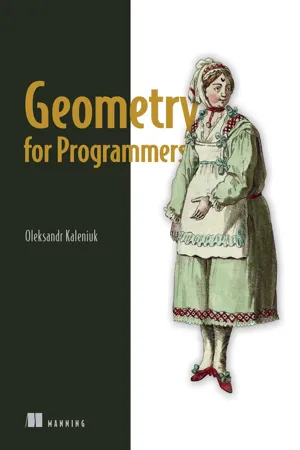
- 440 pages
- English
- ePUB (mobile friendly)
- Available on iOS & Android
Geometry for Programmers
About this book
Master the math behind CAD, game engines, GIS, and more! This hands-on book teaches you the geometry used to create simulations, 3D prints, and other models of the physical world. In Geometry for Programmers you will learn how to:
- Speak the language of applied geometry
- Compose geometric transformations economically
- Craft custom splines for efficient curves and surface generation
- Pick and implement the right geometric transformations
- Confidently use important algorithms that operate on triangle meshes, distance functions, and voxels
Geometry for Programmers guides you through the math behind graphics and modeling tools. It's full of practical examples and clear explanations that make sense even if you don't have a background in advanced math. You'll learn how basic geometry can help you avoid code layering and repetition, and even how to drive down cloud hosting costs with more efficient runtimes. Cheerful language, charts, illustrations, equations, and Python code help make geometry instantly relevant to your daily work as a developer. About the Technology Geometry is at the heart of game engines, robotics, computer-aided design, GIS, and image processing. This book draws back what is for some a mathematical curtain, giving them insight and control over this central tool. You'll quickly see how a little geometry can help you design realistic simulations, translate the physical world into code, and even reduce your cloud services bill by improving the efficiency of graphics-intensive applications. About the Book Geometry for Programmers is both practical and entertaining. Fun illustrations and engaging examples show you how to apply geometry to real programming problems, like changing a scan into a CAD model or developing 3D printing contours from a parametric function. And don't worry if you aren't a math expert. There's no heavy theory, and you'll learn how to offload most equations to the SymPy computer algebra system. What's Inside
- Speak the language of applied geometry
- Compose geometric transformations economically
- Craft custom splines for efficient curves and surface generation
- Confidently use geometry algorithms
About the Reader Examples are in Python, and all you need is high school–level math. About the Author Oleksandr Kaleniuk is the creator of Words and Buttons Online, a collection of interactive tutorials on math and programming. Table of Contents 1 Getting started
2 Terminology and jargon
3 The geometry of linear equations
4 Projective geometric transformations
5 The geometry of calculus
6 Polynomial approximation and interpolation
7 Splines
8 Nonlinear transformations and surfaces
9 The geometry of vector algebra
10 Modeling shapes with signed distance functions and surrogates
11 Modeling surfaces with boundary representations and triangle meshes
12 Modeling bodies with images and voxels
Frequently asked questions
- Essential is ideal for learners and professionals who enjoy exploring a wide range of subjects. Access the Essential Library with 800,000+ trusted titles and best-sellers across business, personal growth, and the humanities. Includes unlimited reading time and Standard Read Aloud voice.
- Complete: Perfect for advanced learners and researchers needing full, unrestricted access. Unlock 1.4M+ books across hundreds of subjects, including academic and specialized titles. The Complete Plan also includes advanced features like Premium Read Aloud and Research Assistant.
Please note we cannot support devices running on iOS 13 and Android 7 or earlier. Learn more about using the app.
Information
Table of contents
- inside front cover
- Geometry for Programmers
- Copyright
- contents
- front matter
- 1 Getting started
- 2 Terminology and jargon
- 3 The geometry of linear equations
- 4 Projective geometric transformations
- 5 The geometry of calculus
- 6 Polynomial approximation and interpolation
- 7 Splines
- 8 Nonlinear transformations and surfaces
- 9 The geometry of vector algebra
- 10 Modeling shapes with signed distance functions and surrogates
- 11 Modeling surfaces with boundary representations and triangle meshes
- 12 Modeling bodies with images and voxels
- Appendix. A Sources, references, and further reading
- index
- inside back cover